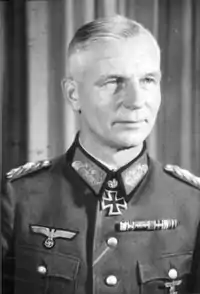Kurt von Tippelskirch | |
|---|---|
 | |
| Born | 9 October 1891 Charlottenburg, Berlin, Kingdom of Prussia, German Empire |
| Died | 10 May 1957 (aged 65) Lüneburg, Lower Saxony, West Germany |
| Allegiance | |
| Service/ | |
| Rank | General of the Infantry |
| Commands held | Army Group Vistula 21st Army 14th Army |
| Battles/wars | |
| Awards | Knight's Cross of the Iron Cross with Oak Leaves |
| Relations | Curt Gallenkamp (brother-in-law) |
Kurt Oskar Heinrich Ludwig Wilhelm von[1] Tippelskirch (9 October 1891 – 10 May 1957) was a general in the Wehrmacht of Nazi Germany during World War II who commanded several armies and Army Group Vistula. He surrendered to the United States Army on 2 May 1945. Tippelskirch wrote several books, such as the History of the Second World War, 1951. He died in 1957.
World War II
On 5 January 1941 he took command of the 30th Infantry Division, which participated in Operation Barbarossa.
As part of Army Group North, the division prevented the breakthrough of a Soviet corps on the river Pola and then went on to counterattack. The battle lasted a week and Tippelskirch distinguished himself as commander of the division, he was awarded on 23 November, the Knight's Cross of the Iron Cross. In the winter of 1942, the 30th Infantry Division was encircled in the Demyansk Pocket, and Tippelskirch was ordered to be flown out.
In August 1942, he was assigned as the liaison officer of the Italian 8th Army near the Don river. This position was extremely difficult for Tippelskirch because he had no German staff at his disposal and the Italians were reluctant to seek advice from German officers. The Italian 8th Army was sent into the Battle of Stalingrad at the end of the year. Tippelskirch was recalled from the front in February 1943.
On 18 February 1943 Tippelskirch became the commanding general of the XII Army Corps. He retained this position until 4 June 1944, when he had to assume command of the 4th Army from General Gotthard Heinrici. Soon after, Operation Bagration against Army Group Center began on 22 June. The 4th Army was defending the Mogilev area and repeatedly requested permission to retreat. The approval came too late, but Tippelskirch along with most of the army managed to withdraw to behind the Dnieper, although 4th Army was still threatened by three Soviet fronts. The 4th Army was encircled east of Minsk on 1 July 1944, and most units of the army were forced to surrender on 8 July 1944. Tippelskirch himself was at the time outside the pocket and escaped capture.
On 18 July 1944 he suffered severe injuries in a plane crash. On 30 July he received the Knight's Cross with Oak Leaves for his achievements in the fighting at Mogilev. On 31 October he entered back into service and replaced the ailing Otto von Knobelsdorff as the commander of the 1st Army in Lorraine. On 13 December of the same year, he took over as the commander of the 14th Army during the Italian campaign. He led the 14th Army until the end of February 1945. At the end of April 1945, Tippelskirch took command of the 21st Army in Mecklenburg and Brandenburg. On 29 April however, General Gotthard Heinrici now the commander of Army Group Vistula was dismissed, and Tippelskirch was ordered by Field Marshal Wilhelm Keitel to temporarily take over command of the army group. He reluctantly did so, taking the opportunity to negotiate with the Western Allies. He surrendered on 2 May 1945 in the Ludwigslust area to American forces. Tippelskirsch was interned in British custody until January 1948.[2]
Awards and decorations
- Iron Cross (1914) 2nd Class (18 November 1914) & 1st Class (20 December 1919)[3]
- Clasp to the Iron Cross (1939) 2nd Class (30 September 1939) & 1st Class (31 May 1940)[3]
- Knight's Cross of the Iron Cross with Oak Leaves
- Knight's Cross on 23 November 1941 as Generalleutnant and commander of the 30. Infanterie-Division[4]
- 539th Oak Leaves on 30 July 1944 as General der Infanterie and deputy commander-in-chief of the 4. Armee[4]
References
Citations
- ↑ In German personal names, von is a preposition which approximately means of or from and usually denotes some sort of nobility. While von (always lower case) is part of the family name or territorial designation, not a first or middle name, if the noble is referred to by his last name, use Schiller, Clausewitz or Goethe, not von Schiller, etc.
- ↑ Charles B. MacDonald (1973). "United States Army in World War II – European Theater of Operations – The Last Offensive: Chapter XIX – Goetterdaemmerung". ibiblio.org. Office of the Chief of Military History. p. 464. Retrieved 2020-07-30.
- 1 2 Thomas 1998, p. 382.
- 1 2 Scherzer 2007, p. 746.
Bibliography
- Mitcham Jr, Samuel W. (2009). The Men of Barbarossa. Commanders of the German invasion of Russia 1941. Havertown: Caseate Publ. ISBN 978-1-935149-15-6.
- Scherzer, Veit (2007). Die Ritterkreuzträger 1939–1945 Die Inhaber des Ritterkreuzes des Eisernen Kreuzes 1939 von Heer, Luftwaffe, Kriegsmarine, Waffen-SS, Volkssturm sowie mit Deutschland verbündeter Streitkräfte nach den Unterlagen des Bundesarchives [The Knight's Cross Bearers 1939–1945 The Holders of the Knight's Cross of the Iron Cross 1939 by Army, Air Force, Navy, Waffen-SS, Volkssturm and Allied Forces with Germany According to the Documents of the Federal Archives] (in German). Jena, Germany: Scherzers Militaer-Verlag. ISBN 978-3-938845-17-2.
- Thomas, Franz (1998). Die Eichenlaubträger 1939–1945 Band 2: L–Z [The Oak Leaves Bearers 1939–1945 Volume 2: L–Z] (in German). Osnabrück, Germany: Biblio-Verlag. ISBN 978-3-7648-2300-9.